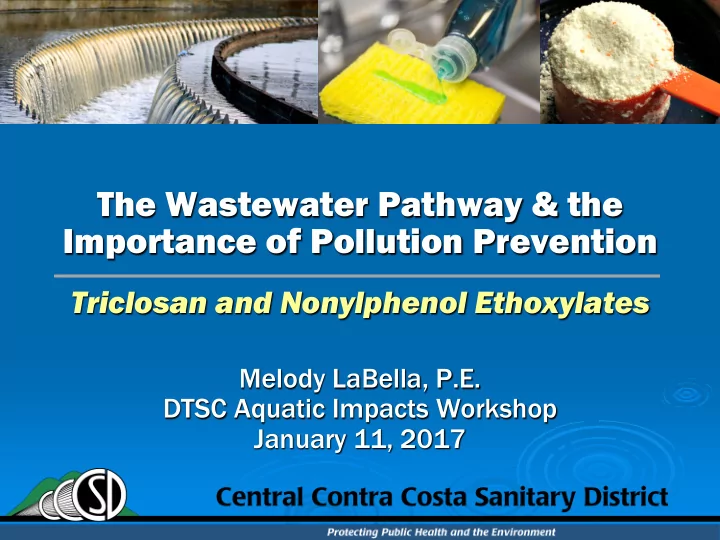

The Wastewater Pathway & the Importance of Pollution Prevention Triclosan and Nonylphenol Ethoxylates Melody LaBella, P.E. DTSC Aquatic Impacts Workshop January 11, 2017
Central Contra Costa Sanitary District (Central San) • 145 sq. mile service area • Serves ~500,000 residents and 3,000+ businesses • >1,500 mile sew er system • Mostly domestic flow 2015 Stats • Treated ~32 MGD w astew ater (avg. daily) • Produced ~600 million gallons of recycled w ater
Wastewater Treatment 101
A i r Effluent Pollutants Recycled Water S o l i d s
More Treatment? • Reverse osmosis, ozone, and advanced oxidation processes can remove or degrade many chemicals, but… • Very high capital costs (rate increases) • High energy demand • High operations & maintenance costs • Brine disposal (shifts CECs to another media) • Some CECs persist • Neutral charge • Low molecular weight
Constituents of Emerging Concern (CECs) • Unregulated chemicals found in low concentrations in the water environment • Not routinely monitored for in wastewater or waterways (sporadic data) • Unknown impact on the environment • Chemicals are innocent until proven guilty • Shifts burden to government agencies
Issues for POTWs • Limited ability to remove CECs • Discharge into surface waters • Toxicity regulation of discharge • Violations and third party lawsuits • CECs can be found in recycled water and biosolids, which could limit options for beneficial reuse.
How POTWs Approach CECs • POTW community becomes aware of a CEC • Waterway monitoring data shows detection • Study shows a downstream aquatic impact • POTWs determine potential sources and pathways to the wastewater stream • POTWs take action where possible, which often has only been doing outreach.
Pollution Prevention • Moving beyond outreach • Legislation • Working directly with manufacturers to make product changes • Regulation
Is it necessary?
Most chemicals used indoors have a pathway to the sewer
Triclosan
Triclosan • Hand soap • Dishwashing products • Laundry detergents • Toothpaste • Deodorants • Shampoo • Cosmetics • Impregnated in products • Toys, cutting boards, sponges
• In 1978, the FDA proposed removing triclosan from certain products. (never finalized rule) • In 2010, NRDC sued the FDA to force issuance of the final rule. • FDA re-issued proposed rule December 2013. • In Fall 2016, FDA announced that Triclosan and 18 other antibacterial agents are banned in hand soaps.
Triclosan • Hand soap • Dishwashing products • Laundry detergents • Toothpaste • Deodorants • Shampoo • Cosmetics • Impregnated in products • Toys, cutting boards, sponges
Nonylphenol Ethoxlates (NPEs)
NPEs • Commercial/industrial laundry detergents • Cleaning products • Paint
NPEs • In the 1970s, NPEs were phased out of household soaps and detergents due to their: • Toxicity • Slow and incomplete biodegradability • Resulting bioaccumulation in aquatic wildlife
Triclosan and NPEs We need your help in reducing the amount of these toxic chemicals reaching wastewater treatment plants in California!
X
Thank You!
Recommend
More recommend